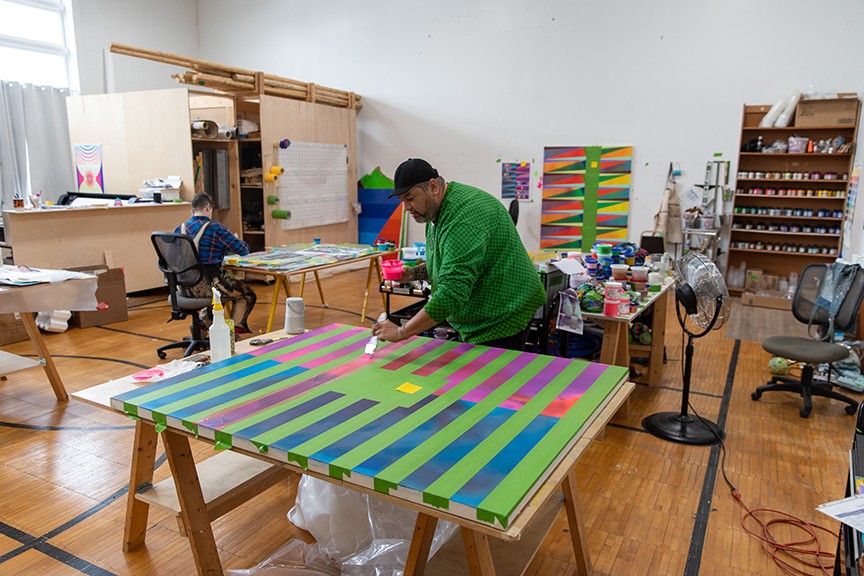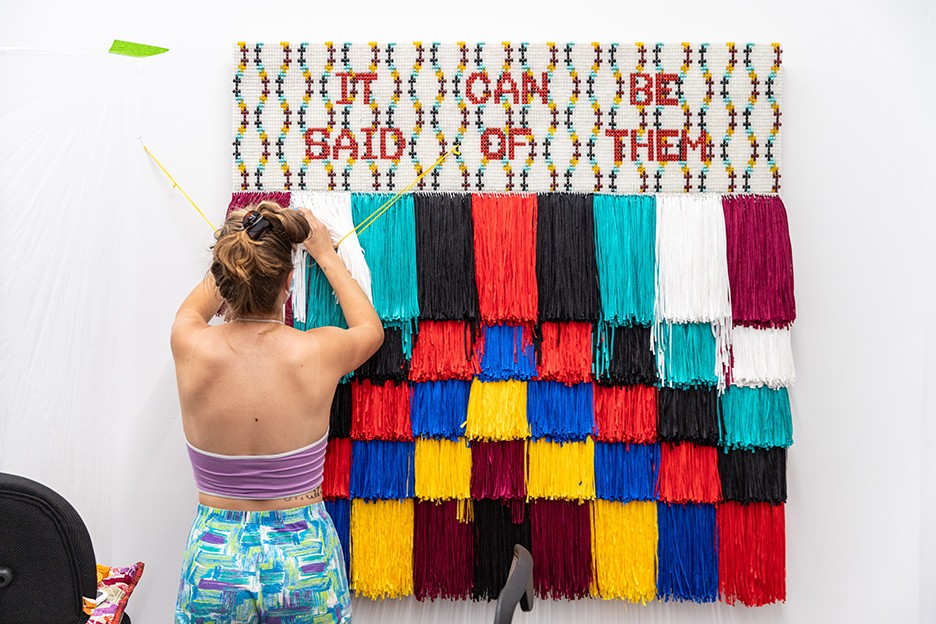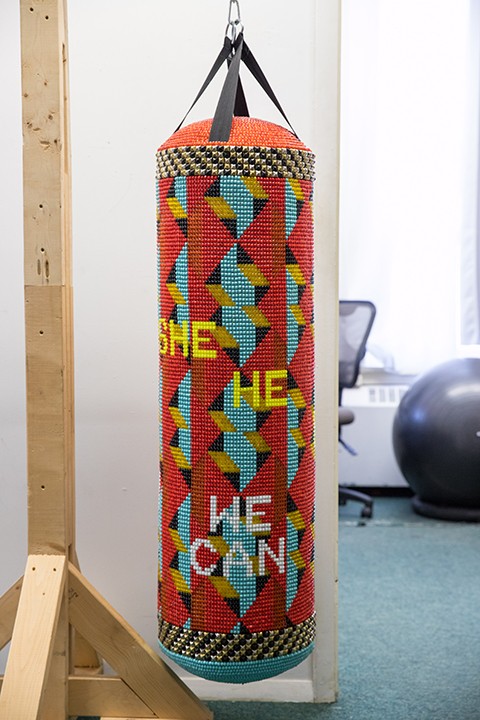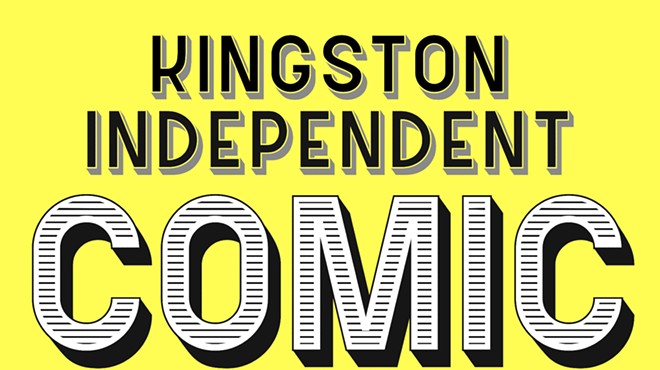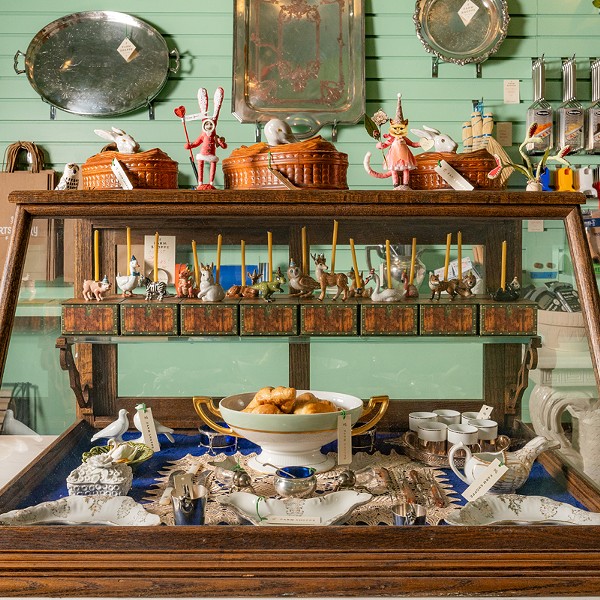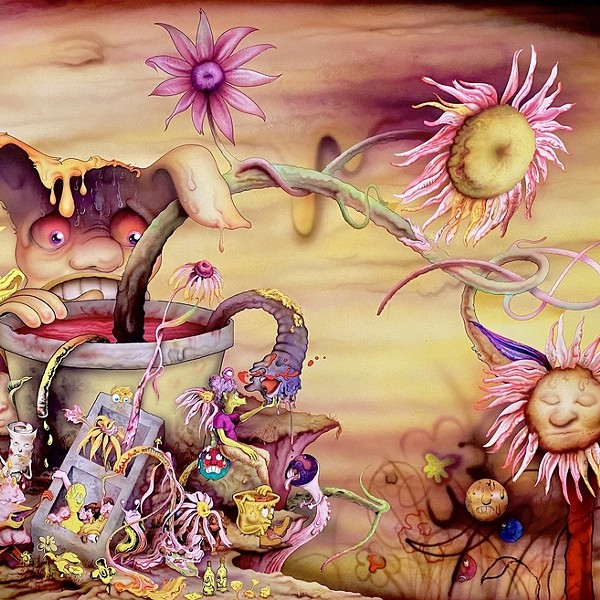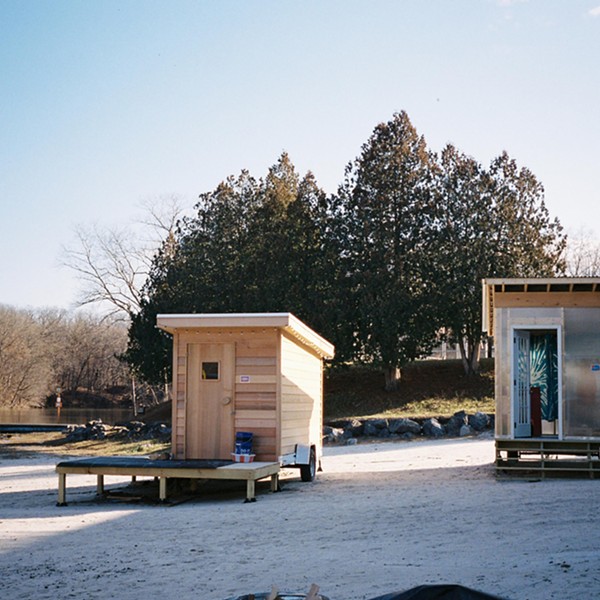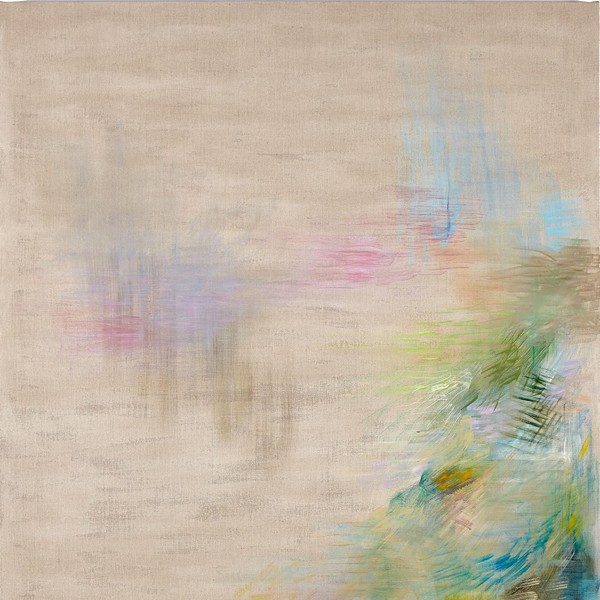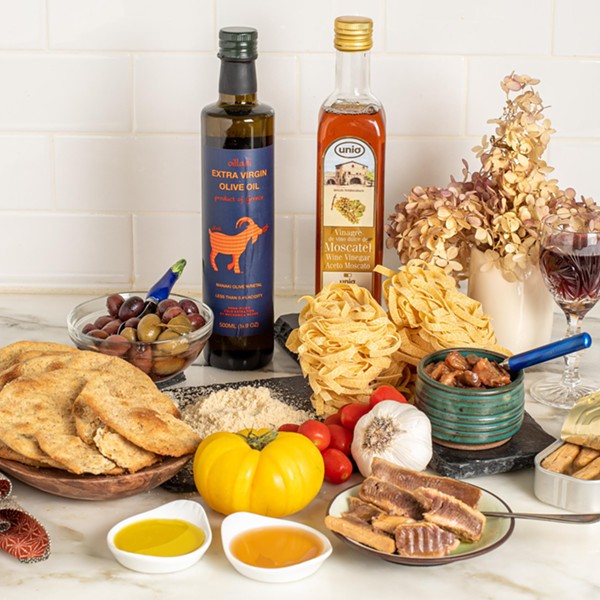Jeffrey Gibson (b. 1972) is a multimedia artist based in Hudson, NY. Gibson’s dynamic art practice explores a diverse cross-section of influences, including Native American indigenous craft traditions, cultural narratives, symbols of power, history, personal identity, and contemporary social issues relevant to BIPOC and queer communities. His singular creative style embraces a range of mediums for expression, such as textiles, embroidery, weaving, hand-sewn fringe, beadwork, and other materials that are the basis for his vibrant assemblage-based paintings, sculptures, garments, and large-scale installations. Gibson’s work often re-contextualizes and thus reconsiders traditional Native American craft within a contemporary cultural framework, resulting in a body of work that is both conscious and celebratory. He regularly exhibits his art at major institutions worldwide and his work is represented in numerous museum and private collections. In March, I spoke with Gibson over Zoom and this is an edited version of that conversation.
Taliesin Thomas: You are such a contributor to the canon of global contemporary art, so this is a joy and a privilege and an honor to speak with you. Please share with our readers any comments about your Native American roots in connection with the Hudson Valley as your home and place of artistic creation. What brought you to the Hudson Valley?
Jeffrey Gibson: Well, you know my ancestry is not from this area originally. My families are located in Mississippi and Oklahoma. My mother is Cherokee and my father is Mississippi Band of Choctaw Indians and so I have grown up being aware of both of those, but I am a member of the Mississippi Band of Choctaw Indians.
I originally came to Columbia County in 2007 for a residency at Art Omi. Honestly, you go a little nuts being on the compound [chuckles], and so I would venture out and I found Hudson and I found [coffee shop] Rev and that became my get away: go to Rev, sit on my computer, and drink coffee. When I left I swore I was never coming back, I was like: ‘I am going back to the city and that’s that!’
And then so many things happened between 2007 and 2012, which led my husband Runey [Rune Olsen] and I to San Francisco for almost a year and a half and then to France—for me for about 7 months and for him about a year. And I think by that point, and kind of even stemming going far back into September 11th, you know, kind of shook everything up and you felt like you had to make a decision: Do you want to stay here or do you want to go elsewhere?
And so, Runey being Norwegian—and we are married in Norway—we have the opportunity to live and work within the EU. And so that was always the question. We knew we wanted to start a family, and after being in [Ponte-en-ven] in France, I was happy. I was happy living in a small town where there was mushroom Wednesdays and fresh bread every morning and little cultural centers that actually were showing interesting art. I was working in the basement of an old house in the middle of this town and I was really happy. So, when we came back, I kind of had this resistance toward moving back to the city. And we both felt that. Runey decided he wanted to stay in the Northeast of the United States, and we both just thought, ‘Let’s give it a go.’
I got the position at Bard, he got a position at Boston University, and that was the beginning in 2012. We moved up here in the summer. We would check-in each year, and we were like ‘Yeah, you know, I am still happy. Are you happy?” And then the studio started growing and then I bought this building that I am in now, which is a turn-of-the-century schoolhouse in Claverack. And then we bought our home and then now I just bought a barn, also in Claverack. At that time of my life I was 40, so the goal was to put down some roots and do a little life editing and trying to secure the things that we knew we wanted to do: my art career, Runey’s art practice, and a family.
"No one was speaking to indigenous audiences from the contemporary art world, and so that to me became something that I was interested in." —Jeffrey Gibson
tweet this
TT: I know I speak on behalf of the worldwide fandom of yours when I say that we are blown away by your celebration of indigenous Native American culture through your practice and your ability to articulate a spectrum through your art. How is that spectrum changing or not?
JG: I think it has shifted, in subtle steps, for sure, but I can feel the real difference now. I think my shift of considering a Native American indigenous contemporary art and culture audience is something that I know is always in the forefront of my brain now and I can feel where it’s been developing. I think when you are Native, you are kind of held accountable by your family, by your community, by other people, whether they are part of your tribal nation or not.
There are these unspoken barriers and lines that we all generally respect. I think I have tried really hard to introduce my content to the contemporary art world in the way that it exists, which I actually appreciate. I am not an “anti-art world” person, which is maybe an important place to start. No one is speaking to indigenous audiences from that contemporary art world, and so that to me became something that I was interested in. Maybe even not as a curiosity, just sort of ‘What does that mean to speak to other indigenous artists?’ So, I have to assume that to some degree we are people who, regardless of what our relationship is to our community—meaning how traditional or not traditional—we have all chosen to make art and put it out into the global world. That’s who I consider to be my art community.
That’s increased the spectrum a lot, and the collaborations, of course, I think are a huge part of it. Rather than extending my own self, I find the people who I am inspired by and I ask then to come together and for me to be able to do the best of what I do, and set it up as a platform for them to do the best that they can do. The original collaborations really go back to 2010 and 2011. I would travel and work with artisans to make things. And then from that, people would refer to it as a collaboration and I said, well, it’s not really a collaboration because there is no back and forth, it’s sort of more of a commission for something that then becomes a part of my practice.
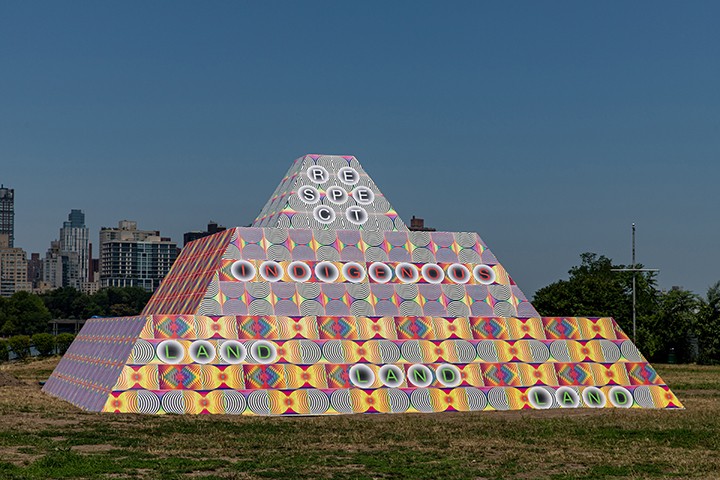
So, the collaborations as a kind of desire to explore what that means with indigenous artists specifically really started there. Socrates [Sculpture Park, Queens, NY] was probably a really good example of when I started using the language of prioritizing indigenous and BIPOC voices and queer voices. Some of the performances before that had that language as well, when we were calling for volunteers for participants. So, that has changed everything, you know? The performance and the videos.
The first stand-alone video was shot in 2015, commissioned by the Denver Art Museum. I always had an interest in video but I think that was the first one where I really started thinking of it as a stand-alone artwork in the way that I think about a painting or the way that I think about a sculpture: it has to be an experience in and of itself. And then I felt like if I just left it as one, that’s like a flash in the pan, so I felt committed to doing two.
I think during COVID quarantine we must have shot, including the Socrates pieces, about four or five videos. So, it was like boot camp. We are getting ready to shoot another one, at the end of this summer. That’s also expanded a ton, because that brings in narrative, that brings in character, it brings in dialogue, movement, and for me it’s sort of the way to experience a space or an object from multiple perspectives rather than your subjective singular perspective when you are in the room with an object.
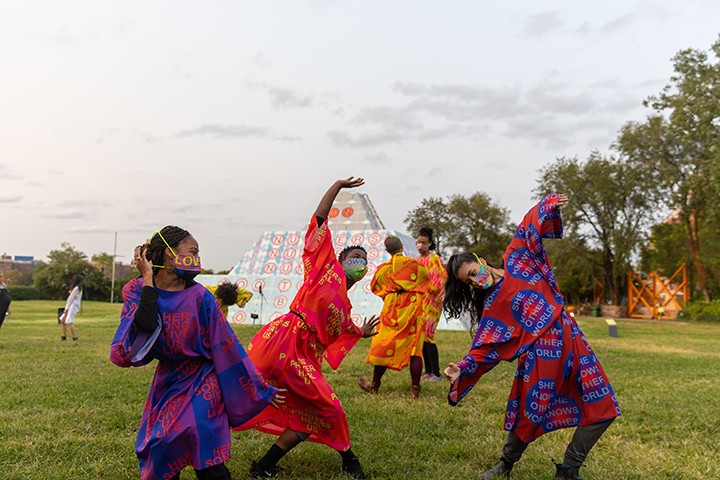
TT: I really to appreciate your candid comments on the so-called “art world” because it truly is a range of things happening, everything from your focus in your studio all the way up to the high end, the commercial and the integrity of museums and so-forth, such a rich dialogue. There is an incredible MacArthur Foundation genius grant clip with you from 2019 and you state: “When I first made the decision that I wanted to have a career as an artist, the first thing I wanted to accomplish was to force Native American aesthetic histories into the conversation with other aesthetic histories globally.” This is such a powerful statement. You also say that you almost gave up doing your art. Please share with us any thoughts about this soul-searching as an artist.
JG: That really goes back, really from the period we moved to New York, Runey and I moved together from London in 1999. So, it was a struggle, I would say from 2000 to about 2002. I got my first studio. We were living in Jersey City. I started teaching, I was working at the Jersey City Museum. I was doing freelance education programming. When we came into the city, you know, it’s kind of like this pressure cooker of an artist’s psychology of feeling all the things you feel: what you are supposed to be doing or you should have achieved. It’s competitive in a way that is complex, it’s layered competitiveness. There are all these voices that you are hearing and you are feeling like you should be out every night. At that time, I was making totally abstract paintings. To me, the marks were informed by weaving, textile weaving, they were informed by beadwork, they were informed by lacing, by basketry, by pattern and also by graffiti. There was this kind of mash-up that was just totally abstract and when I would talk to people about it they would lose interest, they were like: “I don’t see the basket, I don’t see the rug, I don’t see the weaving.”
And so that was the frustration, and to me the content has always been and continues to be as equally important as the aesthetic. To me, they mash and they become one thing. That was the frustration. I was exhibiting and I think for me commercial success has really been important because it was sort of a barrier to break. I was pretty determined to also be a part of that part of the art world and not just remain in nonprofit spaces that were speaking to larger issues. I have been trying to juggle a lot of that all of these years. I guess it was somewhere around 2008, that’s sort of the point for me, a couple of times, I thought about just walking away from it. Initially sometimes walking away, you know, there is a story of me, for instance, cutting all of my canvases off the stretcher bars and taking them to the laundromat. And that is absolutely true and it was totally impulsive and was probably part of the same frustration. That was me wanting to give a big F you to everybody but also take control of my own stuff. I spent a lot of years in therapy and figured out where some of the stuff was coming from.
I think I also expected, growing up, that the art world was a meritocracy. I thought that it was totally inclusive, I thought it was completely queer friendly. So, to get there and run into kind of heteronormative, kind of machismo, and class issues, and race issues, was really disheartening. I couldn’t find the reason big enough to want to put up with it. So, those were the reasons for wanting to walk away.
And at the same time, I am having these conversations with academics, scholars focused on indigenous making, historical indigenous making. That conversation, to me, is so important and so large—so to come into the art world where no one was aware of it, just feels like you are walking off a cliff. That was the reason for wanting to walk away and the big shift was in 2011. I had gotten a few grants to do some traveling and to meet with indigenous makers. I went to Winnipeg in Canada. I went to Oregon, I worked with some people in Oklahoma and then South Dakota. Those all occurred literally because I had a network of people who I asked: “Do you know anybody who I could meet with?” and then those places had a lot of people. So, I would land and I would make appointments with people. I would video everybody, talking to them about their practice. Most of them were working with what we would refer to as craft or artisanal craft and traditional craft.
That is where the commissioning pieces came from and that is the work that showed at Participant [not-for-profit contemporary art space in Manhattan] in 2012. And that was really the big break-through. It was sort of like deciding: am I worried about it being stereotypical, me identifying as Native American, to work with hide, or to work with beads, or to work with these patterns? Is that too cliché? “Am I pigeon holing myself?” is the question that came up numerous times.
I had to turn all those voices off long enough to make the work to see, you know, what does this feel like to do this, to learn bead work? I had learned some beadwork in my teens and 20s, but actually applying it in any kind of substantial way did not happen until around 2008 to 2011. When I showed that work at Participant, I was prepared for that to be my last show. I was like, “Do the show that you want to be thrilled with.” And the premise of that show was really about a show that happened at MoMA in 1941 called “Indian Art in the United States.” In 1941, MoMA wanted to present all of these then contemporary made objects as modern design. Then World War II happens and suddenly the relationship to Native communities totally changes and Native people were being called “socialist” and people were afraid of socialism and all of that programming at MoMA just came to an end.
So, my show was really about: What if that didn’t come to an end? What would it look like if people were still working together today and still addressing the spaces that we live in? That was the first time I felt the city that I always wanted to be an artist in, New York City, finally noticed me and paid attention. I got press and it was the first time I sold some work, not the first time, but through commercial spaces. That was the big shift.
TT: Thank you for your candor. First of all, the candor about the therapy that each of us does in this life. I am personally convinced that personal healing is planetary healing, personal transformation is planetary transformation. You see this in your art in the most outstanding and pronounced and respectful way that draws from such an extraordinary platform, not only the physicality of everything you have just described—the actual materiality and the construction of these artworks—but the overriding spiritual nature of what you do comes across so powerfully. So that brings me to the next question: your art is powerful, empowered, and empowering all at once, it does all of that. How do you define power in art?
JG: Oh, that’s a good question and a big question. Power in art: I think there are lots of different kinds of power, right? I will start with the idea that comes up about whether…is my work meant to be used for, you know, people use the word “ceremony”? I generally shy away from that word because I think ceremony indicates there is a community, an organized community where the ceremonies are already in place. I make my work as artworks with the knowledge that if anybody ever asked me, “Could we bring this into a practice?” I would be open to that happening. But I don’t make them as, you know, garments to be used in that particular way.
And so, I think the garments that I make, the power that comes from them, one: I think when somebody puts them on, which is a huge part of them, somebody has to put them on, whether it’s me or somebody else. When you feel 40 to 65 pounds hanging on your body, and you’ve got tendrils coming from your arms that are like nine feet long, you just immediately start moving in the world in a different way. You go to a place of having to find your balance, you go to a place of having to pull your shoulders back to support it, and when you move your arms, you realize you start playing, you start moving, and watching things move, or sounds happen. I think bringing somebody into a present tense space is empowering because it’s something that we don’t oftentimes do in our day-to-day lives, unless it’s intentional if we create that space for ourselves.
And then I think other people seeing somebody do that is really powerful. Seeing somebody put down the easy performance of navigating through this crazy world, you know, whether it’s being overly polite or being shy and wanting to disappear or control the situation. Just being in your body and feeling in your body, to see that I think is a lesson. It’s a real lesson for people to be like: it’s fine to move in an awkward way, it’s fine to play with gravity as an adult, it’s fine to feel. I think in our contemporary culture we are pulled away from that kind of synchronicity between mind and body. It’s not supported in how we live our lives for everybody.
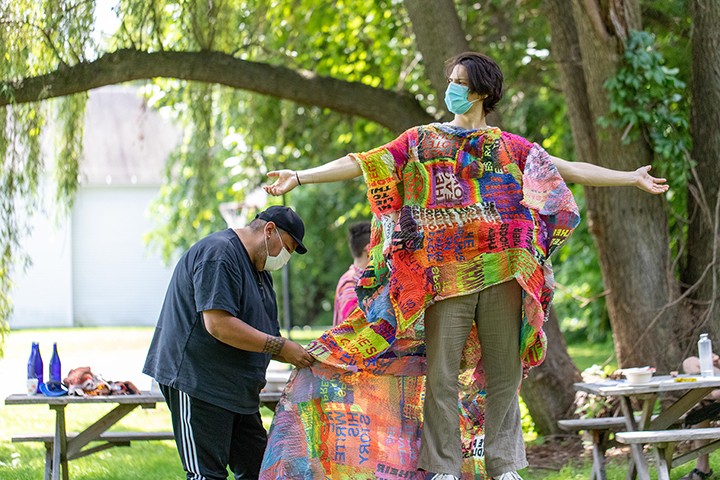
So, there is that and for me, those individuals that I put in the garments, their personal narratives become intertwined by my personal narrative and it leaves an archive that is powerful, that is present tense, that will describe me, of course, but also what was happening in the spaces that I moved through.
I think there are other kinds of power, of course, but I think that for me there is a genuine belief in the animation of materials and of putting together a space. When it goes into community, so for instance, with the performances and I guide people through vocal workshops, there are people who are really shy who are not used to speaking loudly. You connect with them and you pull it out of them. You teach them how to breathe or you teach them how to push their voice out and it’s such an emotional experience. We always have people getting very emotional, including myself.
TT: I am getting emotional just as you are talking because I am thinking about the videos that I watched on this work that you are describing and even as you are animating your body in the discussion, the “nowness” of that, the presence as you say, connecting with self and the physicality—it is very inspiring and it leads to this next question. Continuing with this power concept for a minute, your Punching Bag series, in which you cove Everlast punching bags with glass beads, steel cones, fabric and nylon bangs, is such an outrageous series. You speak about adornment and regalia and how they diffuse the violence of the punching bag. Again, to reference that MacArthur fellow video clip, you speak about things that others have overcome, relationships and power imbalances within those relationships. You also speak about fighting ethically, fairly, that this use of materials is not fists or guns, but this idea about words and intentionality. What was the first inspiration for the Punching Bag series? Was there a moment when the punching bag was it?
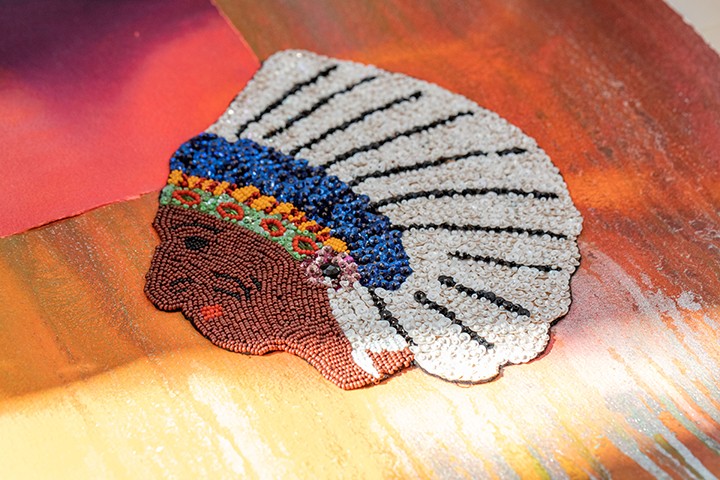
JG: Yes, there are a couple moments. So, when I was in my 20s I worked at the Field Museum, at that time “of Natural History,” in Chicago. My job was to work with tribal delegations to potentially claim items to be repatriated to their communities. My job was to help them assemble the research, so I spent a lot of time in collections and there was always this shelf of unattributed objects where they were not sure how to determine the tribal identity. On that shelf were these, they are called whimsies. They were heavily beaded novelty items that were sold in the Niagara Falls region. They were made by indigenous people there who already had developed a type of traditional beadwork called stacked or raised beadwork. Due to being totally poor, trying to make money, they started looking at Victorian fabrics coming from abroad, of flowers, paisleys, and started trying to replicate this in the stacked beadwork. It became kitsch and it became a souvenir item that was sold cheaply because it wasn’t Native enough and it wasn’t not Native enough to really begin becoming valuable. These pieces I held onto in my head for a long time, thinking ‘That’s me, I am in the middle like this.’
Years later, when I was meeting with artisans, I realized how political it was that they were making their own clothes, they were making their own drums, that they were making their own moccasins, making their own quilts, making their own jewelry, and I realized what a hugely political action that was toward maintaining autonomy and identifying themselves. So, that was the second thing where I realized: that’s amazing.
And then the third thing was in therapy, my therapist at the time pointed out that what he heard from me was that my mind and body were not connected. The anxiety that I felt in my body was not communicating with the articulation of the anxiety in my head. It just left me still. And so those were the three things, and as a means to deal with that he suggested I work with a physical trainer. She was the one who introduced boxing to me. She would ask me, “Who are you angry at? Who is upsetting you? Who is doing this?” And I realized that there was no one single person. It would be easier if I could say it’s Bob and Joe and Mary doing this to me. But it’s not! There are these societal conditions that sometimes are faceless. So that kind of put it together and I just realized one day I could just see adorning the bag, it just happened one day. It was a combination of those three experiences just making sense. It was just like, “Oh! You need to make this bag honor itself in the way that those people honor themselves, that commands respect and honor, that diffuses the violence.”
TT: The work that you do, your exhibitions being this collaboration of ritual objects, costumes, paintings, installation, dance, music, and performances together. We think of this as a kind of Gesamtkunstwerk, a total work of art. How does this come together for you? Is this something that happens in a moment of thinking as an artist? Or is it a work that evolves over time as a collaboration with your past, your present, your team of people that assist you?
JG: I think it’s probably more the latter. I remember the days when I was doing everything, right? I was soaking the hide, I was cutting it in a tiny room. It was hot, it smelled, I remember that. And I remember thinking, “I don’t want to forgo the craft of what I do.” In order to make enough to do a show, to fill a museum space, that’s where the team happened. I think so many of the artisans I have spoken with and people who are really invested in craft, it is therapeutic. That kind of repetitiveness, I think it does heal you. It occupies a certain place and also has the ability to heal you. And I feel like all of the beading that I have done, all the sewing that I have done, it did. It did its job.
So, what we do here in the studio, you stitch on one bead, anybody can stitch on one bead, it’s not hard. It becomes complex when you make all of those beads go in a straight row. It makes it more complex when there are 2,000 beads on something. Suddenly people start reading it as, “Oh! I don’t think I could do that.” Then you start adding in color combinations and patterns to them. But each step is not actually that difficult, and I realize what is so different about this, it’s simple, right? It’s going through a bead, going down through and back up. But that transaction—I call it a transaction—is very different because you get to begin it, you get to be in the middle of it, and you get to end it, and you get to do it again.
This is not something we do in our lives. We are the most miniscule parts of a bazillion transactions that happen every day, and I think it leaves us feeling fragmented. It echoes every symptom of schizophrenia. Craft and the kind of long process of making something is for me very healing, and now that process includes other people, it includes communication, it includes experimentation. My moment of realization, at this point, really happens when I see the work installed and I see how people engage with it, that’s when I get the rush.
TT: Yes, you are giving us that rush every time, thank you! There are so many questions coming out of the things that you are saying. I love when you discuss, as you just described, this infinite use of materials and content, and that outstanding team of collaborators, a very stylized way of working and that interaction with the people that you work with to create these incredible installations.
JG: I will give you an example: For a long time, we put fringe on wall hangings, which makes sense. I am familiar with fringe on the end of a shawl, when people are dancing, that kind of movement. So, with the deCordova fringe cubes it felt so crazy! You know, I was watching 2001: A Space Odyssey for the first time in my life last summer, and I think I kind of always knew what it was about. I watched it, and it was that sculpture, that monolithic form, and I was like: “Oh my gosh, fringe! Monolithic form! I can make that happen.”
Then we started looking into it and suddenly, you move what was a kind of support role material—fringe—to become the subject. You take it from what may be for us, previously a long piece—we have done 9-foot fringe on the arms—but to suddenly make 6-foot cubes with 12-foot fringe, and to do the gradient, it felt crazy! But if you think about it, it’s not any more difficult than something we were doing four or five years ago. I always think of it like you are playing on the DJ board and you are going to turn this volume up, you are going to turn down the bass, you are going to bring up the treble. I just think of it like that, there are all of these things to play with, with all of the materials.
TT: The idea of Futurism seems to be an expanding idea in the art world. Do you have any ideas about Futurism with respect to your work?
JG: Yeah, I do. I started talking about Futurism a long time ago. I think I started talking about it, about the need to be present. We can’t begin to think about a future unless we can feel really grounded in the present tense, so that is where a lot of my thinking about materials and the kind of extraordinary-ness that you can do in quite simple ways, you know, in color—these sorts of things, things that can bring you back to being in one place. Then, to look at a future is actually quite scary because if you have clarity in the present, you see these seemingly insurmountable kinds of challenges ahead of us, mainly ecological. People who know me, I talk a lot about fear and anger. Of course, people are afraid, and of course they are angry. But we can’t solve these problems from fear and anger.
So that to me, the future is quite scary and I think oftentimes people think that I am putting forward a kind of utopic future, and I think that’s where the labor of what I make comes in. I think when people really understand the labor is when they come to visit the studio and they see in a day somebody might finish something this big [gestures to a small size] working on something that is much larger. There is a power in positivity, there is a power in love, there is a power in not being afraid, there is a power in releasing anger. You are actually more powerful when you can release these things rather than holding on to them. The more I feel like these kinds of perspectives evolve, I just see more and more fear and anger around me.
TT: I have to ask this question: The culture that is obsessed with NFTs. Do you have any comment on this NFT culture?
JG: This isn’t pointed at anyone directly, and I am not heavily invested, but I have not seen anything which has made me excited in a way that other artworks have, you know? I was invited to do one, maybe six or eight months ago, someone started talking to me [about it] and all I could say to them was it’s going to take a long time because there is this processing and quality of the hand and humanity and touch and feel and emotion that has to be there in order for it to be a work of mine, right? So, we started going down some paths and things, but I think NFTs exist in such a novelty kind of way and they have a huge investment facet to them, that it’s a really manufactured new art form for lots of reason. So, there are lots of reasons to distrust them in my opinion. But there are people who I think have, even going back to the ‘80s and ‘90s, done amazing things with digital technology that I think they found as their medium because it makes perfect sense for who they are, for their content. But I don’t think NFTs have landed there yet. They were sort of introduced from the outside rather than emerging from the inside, out of the artists’ brain.
TT: What advice do you have for this younger generation of artists rising up and grappling with all these same issues?
JG: Honestly, I think it started for me in the 90s, probably when I was in school at the Art Institute. I think this idea, decentralization, we didn’t call it decentralization then. I worked with a professor at the Art Institute named Maureen Sherlock, who taught a very politically driven art history, so a lot of film in particular. The takeaway that I got from her that I still hold on to is: your opportunity to have freedom exists between well mapped marked spaces. It’s before things form, and the boundaries are set, and the rules are set, and the perceptions are set, that things start getting a little more tight and narrow and stifling. If you can find a space in between, you can define it, you can be whatever you want to be. It’s more of like a concept of just always looking, you know, I can’t get in here, I can’t get in here, but maybe I can carve out a space in-between.







